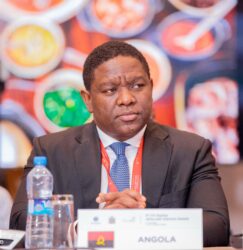The Gold for Oil (G4O) policy was introduced in 2022 to address Ghana’s declining foreign currency reserves and the increasing demand for dollars by oil importers.
These challenges were contributing to the depreciation of the Cedi and a subsequent rise in living costs.
The G4O programme aimed to stabilize the Cedi by leveraging Ghana’s gold reserves to secure competitively priced oil.
Ghana will save about US$4.8 billion in foreign exchange every year as one of the benefits from the Gold-for-Oil policy, the Vice-President, Dr Mahamudu Bawumia, said.
He said the most important aspect of the policy was not just the reduction in fuel prices but the savings the Bank of Ghana (BoG) would make in foreign exchange (forex) as a result of lower demand.
Despite its bold promise, the G4O policy has unravelled as one of the most costly misadventures in Ghana’s recent economic history.
A recent report by the Bank of Ghana revealed that the initiative, once hailed as a masterstroke in macroeconomic innovation, ultimately produced substantial financial losses, distorted the Bank’s mandate, and exposed deep flaws in both conception and execution failures, squarely attributable to the policy leadership of Dr Bawumia.
Turning the Central Bank into a Fuel Trader
The foundation of G4O rested on using locally purchased gold, paid for in Ghana cedis, to acquire petroleum products on the international market ostensibly through barter arrangements.
BoG was thrust into a central role, tasked not just with gold reserve management but with the complex logistics of fuel procurement and payment settlement, typically the function of trade and energy ministries.
This deviation from the Bank’s core mandate, rooted in price and financial stability, saw BoG financing, purchasing, storing, and reselling petroleum products through an unwieldy coordination mechanism involving BOST, PMMC, and oil suppliers.
This operational burden, imposed by a politically driven policy, laid the groundwork for institutional failure.
Massive Foreign Exchange and Trading Losses
Instead of the promised forex savings, the G4O initiative incurred significant losses due to flawed gold pricing mechanisms and currency mismatches. BoG purchased gold at exchange rates aligned with forex bureau rates, significantly higher than the official Bloomberg or BoG reference rates.
This overvaluation caused by a ministerial directive requiring gold purchases at full spot price without discounts, meant that BoG spent more cedis to acquire the same amount of gold, only to sell it at lower effective USD equivalents.
The result was an erosion of foreign reserves and a failure to generate the anticipated $4.8 billion annual savings. Instead, the programme drained valuable FX resources and undermined the central bank’s balance sheet integrity.
A GHS 3.5 Billion Loss
A glaring operational failure occurred at BOST, which accumulated excess fuel stocks worth over GHS3.5 billion by April 2024. This stockpiling occurred as oil prices fell globally, and domestic pump prices declined.
Unable to offload fuel at profitable margins, BOST was forced to sell at below-cost prices, resulting in massive trading losses.
Worse still, the fuel was purchased when the cedi was weaker and gold prices were higher compounding the losses when the time came to replenish gold reserves or convert sales proceeds.
Gold Price Volatility and Timing Mismatches
Another critical misstep in the G4O programme was the inability to manage gold price volatility and timing mismatches. Gold was procured at prices that were often higher than the eventual selling prices, due to a combination of:
- Misalignment between local gold market benchmarks (LME vs Bloomberg)
- Time lags between purchase and sale windows
- Inflexible cash cycles
These factors resulted in the central bank frequently selling gold at a loss, further deteriorating the programme’s financial performance.
Liquidity Trap and Inefficient Cash Flow
The G4O model operated on an inefficient and convoluted cash cycle. BoG would:
- Advance cedis to BOST.
- Use those cedis to buy gold.
- Convert gold to USD to pay international oil suppliers.
- Wait for BOST to sell fuel to BDCs and return proceeds.
The time lag between these activities created exposure to gold and FX market volatilities, delayed cash recirculation, and ultimately impaired the Bank’s working capital cycle.
IMF Recommendation: BoG Exits G4O Programme, Now Resolving Residual Losses
In a candid assessment, the Financial Markets Department of the Bank of Ghana formally recommended and has since implemented an exit from the G4O programme, aligning with the position of the International Monetary Fund (IMF).
The Bank has officially withdrawn from all fuel trading and financing activities under the initiative, ceding those responsibilities entirely to BOST and its bankers.
This strategic withdrawal enables the Bank of Ghana to refocus on its core mandate, managing price stability and building reserves primarily through its Domestic Gold Purchase Programme (DGPP), which remains operational.
However, the exit has not come without cost. The Bank is currently addressing several residual outstanding issues, including financial losses linked to foreign exchange differentials, valuation gaps from gold transactions, and fuel stockpile-related exposures.
These cleanup efforts are aimed at stabilizing the Bank’s balance sheet and restoring policy discipline after a costly deviation.
This entire episode underscores the failure of the G4O initiative not merely in its flawed design and poor execution, but in its fundamental violation of central banking norms. It stands as a powerful caution against using the central bank as a tool for politically motivated economic experiments.
Dr Bawumia’s Responsibility
As the architect and chief promoter of the Gold for Oil policy, Dr Bawumia bears significant responsibility for its failure. He steered the programme’s design and political rollout, repeatedly touting its forex-saving benefits without establishing the operational and governance structures to manage its inherent risks.
By pushing the central bank into an active role in commodity trading, Dr Bawumia compromised its independence, exposed it to commercial risks, and created an economic experiment that, rather than stabilizing the cedi, destabilized institutional credibility.
Conclusion
The Gold for Oil policy was marketed as a bold and transformative initiative to save forex, stabilize fuel prices, and strengthen the cedi. In practice, it became a cautionary tale of political overreach, operational mismanagement, and the misapplication of central bank resources.
With over GHS3.5 billion in fuel losses, billions in exchange rate mismatches, and an erosion of the Bank of Ghana’s core mandate, the G4O policy under Dr Bawumia not only failed to deliver on its promises but inflicted lasting damage on the country’s monetary credibility.
As Ghana moves to unwind this programme, policymakers must draw the right lessons: central banks are not trading houses, and sound economic management must always outweigh political expediency.










